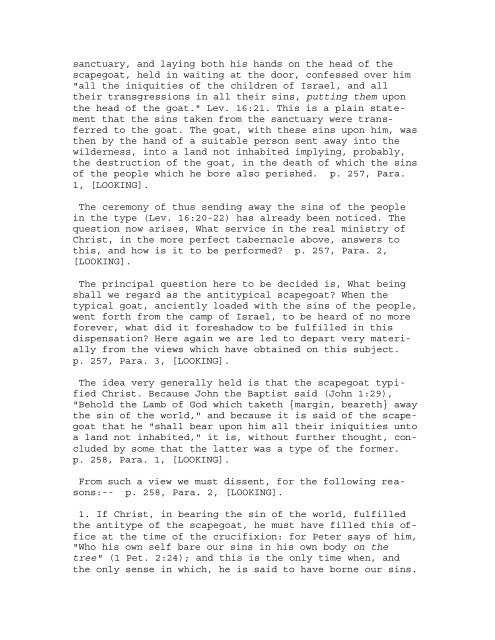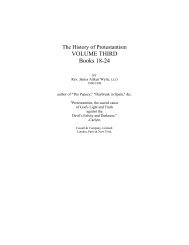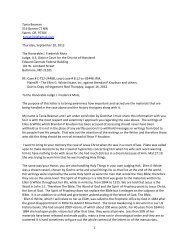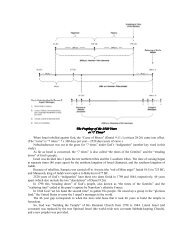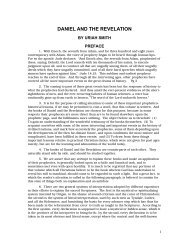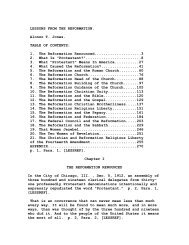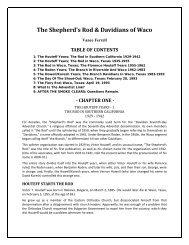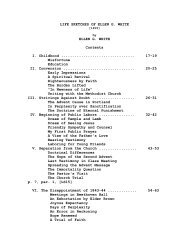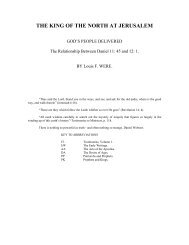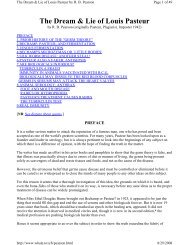LOOKING UNTO JESUS OR CHRIST IN TYPE AND ANTITYPE. BY ...
LOOKING UNTO JESUS OR CHRIST IN TYPE AND ANTITYPE. BY ...
LOOKING UNTO JESUS OR CHRIST IN TYPE AND ANTITYPE. BY ...
You also want an ePaper? Increase the reach of your titles
YUMPU automatically turns print PDFs into web optimized ePapers that Google loves.
sanctuary, and laying both his hands on the head of the<br />
scapegoat, held in waiting at the door, confessed over him<br />
"all the iniquities of the children of Israel, and all<br />
their transgressions in all their sins, putting them upon<br />
the head of the goat." Lev. 16:21. This is a plain statement<br />
that the sins taken from the sanctuary were transferred<br />
to the goat. The goat, with these sins upon him, was<br />
then by the hand of a suitable person sent away into the<br />
wilderness, into a land not inhabited implying, probably,<br />
the destruction of the goat, in the death of which the sins<br />
of the people which he bore also perished. p. 257, Para.<br />
1, [<strong>LOOK<strong>IN</strong>G</strong>].<br />
The ceremony of thus sending away the sins of the people<br />
in the type (Lev. 16:20-22) has already been noticed. The<br />
question now arises, What service in the real ministry of<br />
Christ, in the more perfect tabernacle above, answers to<br />
this, and how is it to be performed? p. 257, Para. 2,<br />
[<strong>LOOK<strong>IN</strong>G</strong>].<br />
The principal question here to be decided is, What being<br />
shall we regard as the antitypical scapegoat? When the<br />
typical goat, anciently loaded with the sins of the people,<br />
went forth from the camp of Israel, to be heard of no more<br />
forever, what did it foreshadow to be fulfilled in this<br />
dispensation? Here again we are led to depart very materially<br />
from the views which have obtained on this subject.<br />
p. 257, Para. 3, [<strong>LOOK<strong>IN</strong>G</strong>].<br />
The idea very generally held is that the scapegoat typified<br />
Christ. Because John the Baptist said (John 1:29),<br />
"Behold the Lamb of God which taketh {margin, beareth} away<br />
the sin of the world," and because it is said of the scapegoat<br />
that he "shall bear upon him all their iniquities unto<br />
a land not inhabited," it is, without further thought, concluded<br />
by some that the latter was a type of the former.<br />
p. 258, Para. 1, [<strong>LOOK<strong>IN</strong>G</strong>].<br />
From such a view we must dissent, for the following reasons:--<br />
p. 258, Para. 2, [<strong>LOOK<strong>IN</strong>G</strong>].<br />
1. If Christ, in bearing the sin of the world, fulfilled<br />
the antitype of the scapegoat, he must have filled this office<br />
at the time of the crucifixion: for Peter says of him,<br />
"Who his own self bare our sins in his own body on the<br />
tree" (1 Pet. 2:24); and this is the only time when, and<br />
the only sense in which, he is said to have borne our sins.


